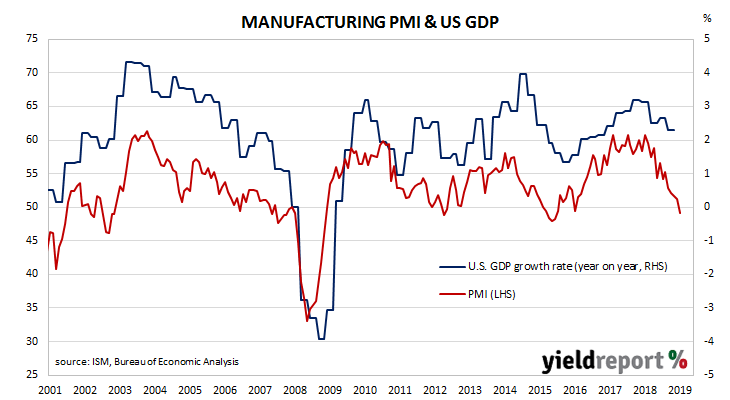US purchasing managers’ indices (PMIs) have been sliding since August 2018, albeit from elevated levels. After reaching a cyclical peak in September 2017, manufacturing PMI readings went sideways for a year before they started a downtrend. The latest reading has continued this trend.
US manufacturing activity has slowed for a fifth consecutive month, taking it to a level which is defined as contractionary. According to the latest Institute of Supply Management (ISM) survey, its Purchasing Managers Index recorded a reading of 49.1, down from July’s reading of 51.2 and less than the market’s expected figure of 51.5. The average reading since 1948 is 52.9 and any reading below 50 implies a contraction.
NAB economist Tapas Strickland said, “The slide below 50 means that US manufacturing is moving more in line with an evident global manufacturing recession, as depicted by the JPM Global Manufacturing PMI, which came in at 49.5 for August from 49.3, having fallen below 50 back in May.”
He said the figures will have implications for US monetary policy and the US dollar. “How the Fed now responds to the news that a bellwether economic indicator has turned south will be key in whether markets start to price more aggressive easing and, in turn, whether the higher US dollar, which continues to be an additional headwind to US economies on the global stage, now stabilises or evens pulls back.”

US financial markets responded by sending Treasury yields lower while expectations of US rate cuts hardened. US Treasury bond yields fell, especially at the short end and, by the end of the day, 2-year bond yields had fallen by 5bps to 1.46%, 10-year yields were 4bps lower at 1.46% and 30-year yields had slipped 1bp to 1.95%. In terms of likely US monetary policy, according to federal funds futures contracts the implied probability of a 25bps cut or greater at the FOMC’s September meeting increased from 95% to 100% while the likelihood of another additional cut at the December meeting remained at 86%.

